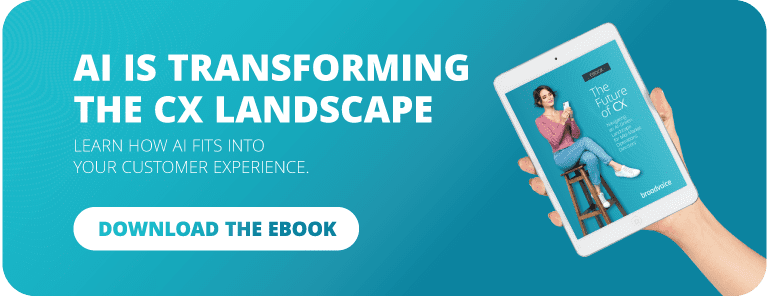With the rapid acceptance and adoption of AI technology, it seems everyone has a crush on artificial intelligence. And for good reason! It’s flashy. It’s fresh. It promises to solve all our problems. And contact centers, in particular, are falling for it fast and hard. In fact, Deloitte reports that up to 81% of contact center execs are actively investing in AI for agent-enabling tech.
But the reality is that many companies are moving too fast with AI. They’re diving into the deep end without a strategy, hoping it will fix all their problems. This fast and furious adoption of AI is distracting from the fundamental purpose of their work: supporting their employees and building a rich, authentic customer experience.
Adding AI for the sake of adding AI won’t get you anywhere. It may even damage your operational efficiency and harm your CX. That’s why it’s critical to build an AI customer experience carefully and strategically, focusing on your customers and balancing technology with the human touch.
By remaining customer-centric, AI can transform the customer experience, enabling deeper insights, greater personalization, and broader efficiency.
The Increasing Importance of Customer Experience
Customer experience matters. A lot.
One report shows that 80% of customers believe the experience a company provides is as important as its products and services. Yet, expectations for a great experience are ever-evolving, creating a gap you need to fill. In fact, Salesforce reports that 63% of buyers believe most of their experiences fall short of what they know is possible. And consistently falling short can become a huge problem.
Let’s put on our consumer hats for a minute.
Imagine a new coffee shop opens down the street from you. You eagerly try it, ordering your usual: an oat milk vanilla latte. But, oops! They give you almond milk instead of oat milk. Ok, one mistake isn’t a big deal. But the next few times you go, more mistakes are made. The hot coffee you order comes out iced. They forget to add the shot of espresso you paid extra for. Another time, they forget your order altogether.
How many mistakes would you tolerate before going elsewhere?
Nowadays, customer loyalty hinges on your ability to deliver exceptional experiences every time. PwC reports that 59% of customers will walk away after several bad experiences, even if they love a company or product. Your ability to consistently deliver great experiences can make or break your long-term success.
How do you exceed expectations when the competition is so high? That’s where AI comes in.
What is an AI Customer Experience?
An AI customer experience refers to using artificial intelligence technology to enhance and optimize the customer experience. AI tools and applications allow organizations to improve efficiency, personalization, and customer satisfaction. Think of AI as that extra sprinkle of salt on your customer experience. It enhances the flavor, making a good experience more memorable.
With AI in your customer experience, you can:
- Move faster and offer instant interactions using chatbots and virtual assistants.
- Tailor interactions and recommendations using customer data.
- Stay proactive, anticipate customer needs, and proactively address potential issues using predictive analytics.
- Be consistent and maintain quality with AI tools.
- Improve performance and optimize customer feedback mechanisms for better performance management.
How AI Impacts the Customer Experience (+ Use Cases)
Adding AI to your customer journey can be transformative. Here are some ways to strategically use AI to deliver a better customer experience in your contact center.
Use AI to Enhance and Scale Personalization
We crave personalization — and AI delivers it. You may not be aware of it, but AI is already integrated everywhere, using your preferences and interests to craft a personalized experience.
Netflix recommends what you should binge next. Your Instagram feed is populated by ads catered to your interests. Doordash suggests food options based on your previous orders.
These tailored experiences result from companies using data analytics to target your interests and needs, boosting personalization and encouraging you to remain loyal and engaged.
How AI-Driven Personalization Works
Every day, customer data flows into your contact center, revealing behavior trends, personal preferences, and purchasing patterns. Each time a customer clicks a button, views a page, makes a purchase, or abandons a cart, it reveals something about their experience with your brand.
Don’t you want to know what that “something” is?
With AI-powered advanced analytics, brands can gather and interpret data to discover trends in customer behavior and preferences. This enables brands to tailor their services and messaging to create highly personalized customer experiences at scale. The result? Increased brand loyalty, higher customer satisfaction, and a strong bottom line.
3 Ways to Use AI to Enhance Personalization
- Recommend helpful resources and content. AI can recommend specific content and resources to improve self-service and engagement. By tracking a customer’s FAQs and knowledge base searches, you can anticipate their needs, share relevant content and resources, and help them find useful information quickly.
- Prompt additional purchases. Track past purchases, clicks, and page views to see what interests customers and suggest new features or services. You can use this information for marketing campaigns or upselling during interactions.
- Personalize conversations. Customers like to feel known. AI-powered tools like text, speech, and sentiment analytics allow agents to adjust how they speak and address each customer. Use personalization data to add unique details and use customer’s history to make them feel special.
Use AI to Provide Round-the-Clock, Speedy Support
Imagine you’re racing to finish a presentation for work, but you’re struggling to figure out the reporting tool in your CRM. It’s nearly midnight — how are you going to get help? Thankfully, your vendor has an AI chatbot on their website. Within a few minutes of chatting with the bot, you have step-by-step instructions on how to pull the exact report you need for your presentation the next morning. Phew!
This kind of AI technology has revolutionized how customers get support, allowing contact centers to provide instant, accurate help at all hours of the day.
How AI-Powered Support Works
Every second, another customer inquiry comes into your contact center. But only so many human agents are available at a given time. If there’s a disproportionate ratio between the number of customers who need help and the number of agents available to assist them, other issues arise.
Customers wait on hold. They get grumpy and draft a bad review. Agents can barely take a break and suffer from burnout. CSAT drops. Agents quit. It’s a mess.
Consider this: customers are 2.4X more likely to stick with a brand when their problems are resolved quickly. So, when a customer sends a message, makes a call, or initiates a chat, don’t you want to provide instant, accurate help whenever and wherever they need it? With AI-powered tools like chatbots and IVAs, you can offer more efficient support, instantly resolve common queries, improve self-service options, and use intelligent routing to direct complex issues to the right agents.
3 Ways to Use AI for More Efficient Service
- Use chatbots to answer FAQs. AI chatbots integrated with your live chat and SMS channels can handle frequently asked questions and share useful resources with customers 24/7. Chatbots can also lower the volume of incoming calls, alleviating agent burnout and freeing them to spend time on more complex issues.
- Route customers to the best help. Intelligent routing tools use AI to analyze customer queries. Then, they direct customers to the most suitable agents and departments based on expertise and availability. Use advanced routing to reduce wait times and improve accuracy (which boosts FCR).
- Improve self-service with IVAs. Intelligent virtual assistants are like chatbots for your phone channels. These AI tools provide conversational support using natural language processing (NLP) to understand and address customer needs. With IVAs, you can offer 24/7 human-like support to improve self-service.
Discover the benefits of adding AI to your contact center.
Use AI to Empower Your Employees
Customers expect you to be the expert. So, it’s not a good look when your agents are poorly equipped to help customers. Plus, your agents want to do their jobs well.
With strategic integration, AI tools partner with your employees, empowering them to do better at their jobs and deliver exceptional service. With AI, your team can work faster and smarter.
How AI-Powered WFA Works
Try as you might, you can’t answer every agent’s question and coach every team member through a call. AI partners with you as a coach, helping you support your agents with training, automation, and optimal scheduling.
With AI technology, you can analyze performance data, identify skills gaps, and offer personalized training programs to target specific performance issues. Workflow automation handles routine tasks, allowing agents to focus on high-value interactions. Plus, adding AI to your workforce management tools helps you optimize resources so you’re always adequately staffed.
3 Ways to Use AI to Empower Employees
- Tailor training to fit agents’ unique needs. Advanced analytics can assess agent performance and tailor training programs to address their specific needs. You can implement agent training bots that use sentiment, speech, and text analytics to coach agents through tricky interactions in real time.
- Streamline tasks with workflow automation. Automate repetitive tasks like ticket categorization and data entry to relieve agents of tedious, redundant tasks that often lead to burnout. This empowers agents to concentrate on more complex and engaging customer interactions. (After all, that’s what the job is about, right?)
- Enhance workforce management. Integrate AI in your workforce management tools to optimize scheduling, forecasting, and resource allocation. By predicting call volumes and adjusting staffing levels accordingly, AI ensures the right number of agents are available at the right times, reducing wait times and improving the customer experience. Job and customer satisfaction increase when your team is optimized to do their best work.
Learn more about how WFM streamlines operations in this blog.
Strategic Steps Toward an AI Customer Experience
As we mentioned before, integrating AI requires care and strategy. Otherwise, you’ll end up with a big mess on your hands. Before diving headfirst, build your AI strategy with these steps.
Step 1: Assess Your Needs
Identify areas where AI adds the most value for your team and processes. You should also gather data and feedback from your customers to determine your current CX challenges and opportunities.
- Pro Tip: Involve stakeholders early. Take the time to gain internal alignment. Engage key stakeholders from different departments to ensure buy-in and collaboration throughout the implementation process.
Step 2: Set Clear Objectives
Don’t go in without a goal. Define what you want to achieve with AI. Do you want to reduce wait times? Improve customer satisfaction? Reduce turnover?
- Pro Tip: Start small. To ensure you hit your goals, start with pilot projects that test AI solutions before doing a full-scale integration.
Step 3: Select the Right AI Tools
Take the time to research and choose AI solutions that align with your objectives. Work closely with other teams in your organization to ensure the new tools integrate seamlessly with your existing systems.
- Pro Tip: Focus on security. Look for a vendor that prioritizes data privacy and security to protect customer information.
Check out these AI-powered tools to boost your contact center operations.
Step 4: Train Your Team
AI is disruptive, so it’s important to take time to prepare your team to work alongside AI. Then, collect feedback from your team as you go so you can ensure the solution fits their unique needs.
- Pro Tip: Balance AI with the human touch. Be thoughtful about how you combine AI efficiency with human empathy so you can provide a well-rounded customer experience.
Step 5: Monitor and Optimize
AI learns and improves over time using machine learning. That’s why it’s critical to continuously evaluate the performance of your AI tools and make adjustments to optimize their impact on CX.
- Pro Tip: Stay updated. Keep up with the latest AI advancements and continuously update your AI strategies to stay competitive.
Go.AI: Your AI Partner for a Seamless Customer Experience
Broadvoice understands the transformative potential of an AI customer experience. Go.AI enhances self-service with a natural language bot that is built into your IVR. This lets you empower your customers with self-service, reduce wait times, and boost CSAT. Then, intelligent routing improves your efficiency and optimizes your customer journey to increase FCR and relieve pressure on your agents.
We want to serve you as a partner, so our solution is designed with flexibility in mind. You can customize it to create a lasting, successful AI strategy that aligns with your organization’s CX needs and goals.


















